Horse Drawings Easy Steps Horse Head Drawings Easy Steps
Majestic, strong, and elegant, horses are one of the animals most loved by humans. With their strong legs and long flowing manes, it is not difficult to see why horses are a favorite subject for many artists. Despite their popularity, many artists struggle with the drawing of a horse. It can be tricky to get the proportions right, and horses have very specific features which make it clear when you do not quite get it right. If you want to know how to draw a horse, we have created an easy-to-follow tutorial. If you want to conquer this magnificent beast, gather your drawing supplies and read on.
Table of Contents
- 1 Horses and Humans
- 2 How to Draw a Horse Step-by-Step
- 2.1 Step 1: Constructing the Horse's Main Body
- 2.2 Step 2: Constructing the Horse's Head
- 2.3 Step 3: Constructing the Horse's Muzzle
- 2.4 Step 4: Constructing the Horse's Neck
- 2.5 Step 5: Constructing the Horse's Ears
- 2.6 Step 6: Constructing the Horse's Tail
- 2.7 Step 7: Constructing the Horse's First Front Leg
- 2.8 Step 8: Constructing the Horse's Second Front Leg
- 2.9 Step 9: Constructing the Horse's First Back Leg
- 2.10 Step 10: Constructing the Horse's Final Leg
- 2.11 Step 11: Fine Lining the Horse's Outline
- 2.12 Step 12: Drawing the Tail and Main Blowing in the Wind
- 2.13 Step 13: Adding Details to the Horse's Legs
- 2.14 Step 13: Adding Texture and Details to Your Horse
- 2.15 Step 14: Finishing Your Easy Horse Drawing
- 3 Frequently Asked Questions
- 3.1 Does this Tutorial Make Horse Legs Drawing Simple?
- 3.2 How Long Does It Take to Create a Drawing of a Horse?
Horses and Humans
Since 3500BC, horses and humans have had a long and fruitful working relationship. From pulling carts and plows to carrying humans on their backs, horses are strong and dependable creatures. Horses have very muscular bodies that shift and change as they are in motion. To be able to do this elegant and beautiful animal justice, we need to be able to capture this motion throughout their bodies. Horses also have very long legs with many curves and joints that seem much harder to draw than they actually are.
In this how to draw a horse step-by-step tutorial, we will lead you through all the steps to help you nail the right perspective and capture this stunning horse in all of its glory.
How to Draw a Horse Step-by-Step
Our resident artist has created this tutorial using pencil on paper, but you are more than welcome to follow along in your chosen medium. Whether you are a graphic artist who uses adrawing tablet, or your favorite medium is watercolor, you can adapt this easy horse drawing tutorial. If you are ready to tackle the intricacies of drawing a horse, gather your supplies, and let us get started!
Step 1: Constructing the Horse's Main Body
For all of ouranimal drawing tutorials, we always begin by using construction shapes and lines. Construction lines are simple and easy-to-draw shapes that help us construct the basic shape of our animal before we begin adding complicated details. Construction lines are used by professional and beginner artists alike, and they are sometimes referred to as an artist's best-kept secret.
To begin our drawing of a horse, we are going to use a long, horizontal oval to represent the horse's main body. This first step is deceivingly simple because while it is just an oval, you need to make sure that it is placed perfectly on your page.
All around this oval, you will be adding other limbs and details, so you need to make sure that there is plenty of space so that your horse does not end up with a squashed neck.
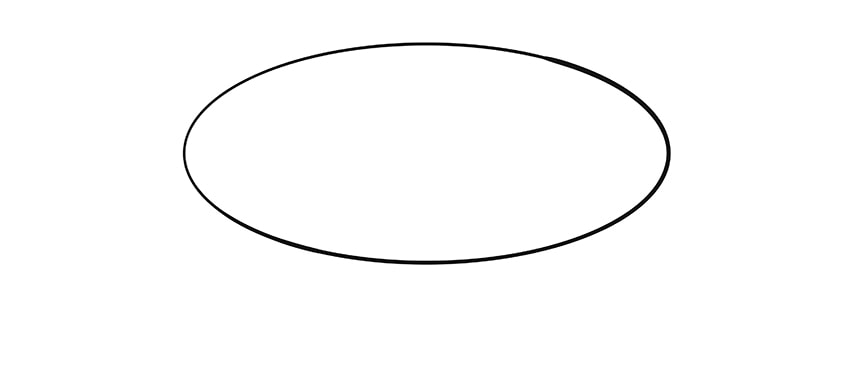
Step 2: Constructing the Horse's Head
The second step in this easy horse drawing tutorial is also a simple construction step, but it is essential. In this step, you are going to use a small circle to represent the head in your drawing of a horse. To the right and above the main body construction oval, draw a small circle. You want the circle to be just above, and just in front of the main oval.
At this stage, it does look strange for your horse's head to be hanging so far away from the body. In the next few steps, you will draw the horse's neckline to join the two body parts together.
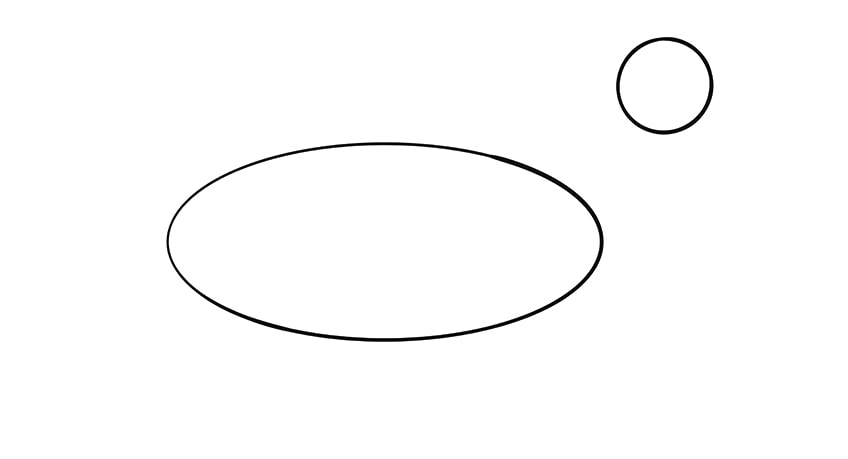
Step 3: Constructing the Horse's Muzzle
Before you join the head to the body, you need to quickly construct the muzzle of the horse. For the muzzle, you are going to use an oval shape that slopes at a 45-degree angle down towards the bottom right corner of your page. The top of this oval should overlap quite a lot with the head circle.
In the next few steps, you will use this oval to help perfect the shape of the horse's head and nose.

Step 4: Constructing the Horse's Neck
Finally, the time has come to join your horse's head with its body. Begin with a curved line that starts at the very top of the head construction circle and curves down onto the top of the body oval. You want this line to join with the body oval just before the halfway point. Use another, smaller curved line to finish the neck, beginning just below the horizontal halfway point in the head circle, and join this to the body. You will use these lines to help you complete the final outline of your horse's neck in later steps.
At this point, you may begin to see the shape of a horse poking through the construction lines.

Step 5: Constructing the Horse's Ears
Adding the horse's ears immediately transforms your construction drawing and helps you to see the horse come to life. To construct the ears, you are going to use two slightly differently shaped ovals. Begin where the neckline joins the head circle. At this point, draw a long and thin oval shape that comes to a point at the top. This front ear should look a little like a long petal. Just behind this first ear, draw another oval that is fatter and does not come to as much of a point.
The difference in the ear shape is the result of the perspective we are using for this drawing of a horse.

Step 6: Constructing the Horse's Tail
For all the steps so far, you have used shapes to represent the different parts of the horse's body. In this step, you are going to use a freehand curved line to create the general shape for the horse's tail. The horse that we are drawing is on the move, so the tail is going to be flowing backward.
It may take a couple of tries until you are happy with the shape of your tail, but be patient, these things take time.

Step 7: Constructing the Horse's First Front Leg
We have broken down the horse legs drawing steps into a few parts because they are arguably the most tricky part of the horse drawing to nail. In this first horse legs drawing step, we are going to tackle the front back leg. Begin by drawing two small circles about a centimeter apart from each other. These two circles represent the two joints in the front leg.
The top circle should be in line with the head circle and should be the same distance away from the body as the head is.
Attach these circles to the main body oval with two lines that are as wide as the circles. You want to make sure that these lines are not two solid lines all the way down the leg. Instead, you want the lines to separate in between the circles. At the bottom of the bottom circle, draw a small curved triangular shape. This triangle will be the outline for your horse's hoof.
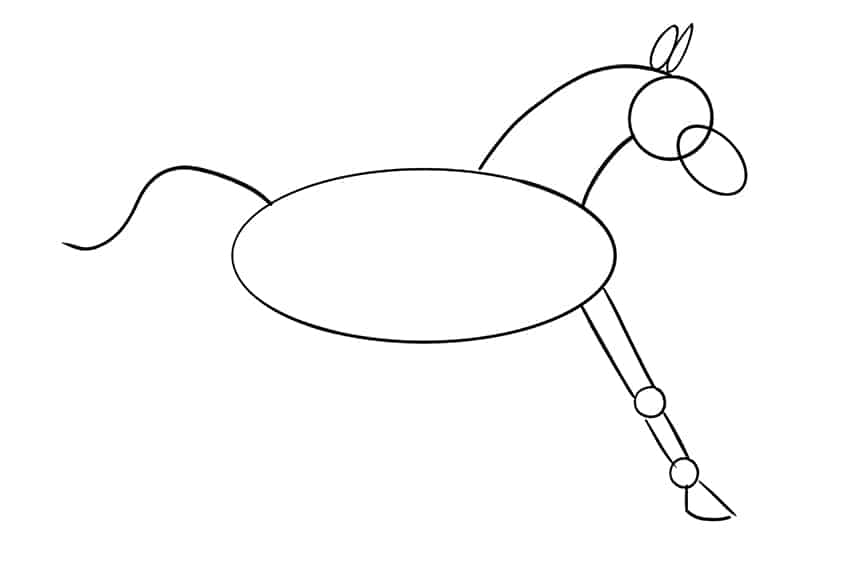
Step 8: Constructing the Horse's Second Front Leg
In this step, you are going to use the same process to construct the second front leg. This front leg is the one closest to us, and it is bent as the horse is in motion. Again, you want to draw two circles to represent the joints, but these circles need to be in slightly different places.
If you use the two circles for the first front leg as guidelines, you want the top circle for this second leg to be behind them but in the middle of them.
Then, you can draw the second circle just below this first one and about a centimeter behind it. Use two lines to join these circles to the main body and each other. Because this front leg is closest to use, you can make the leg a little wider at the top where it joins the body oval. The final part of this step involves drawing a tear-drop shape around the bottom circle. This circular tear-drop shape will represent the hoof for this leg.

Step 9: Constructing the Horse's First Back Leg
You know the drill by now. In this step, you need to construct the back leg that is closest to you. The two joint circles need to be directly in line with the two in the very front leg. You also want to make sure that the bottom circle is in front of the top one. Because this back leg is the one closest to us, you want the top of the leg to be quite wide.
Finish this step by drawing another slightly curved triangle extending from the bottom circle.
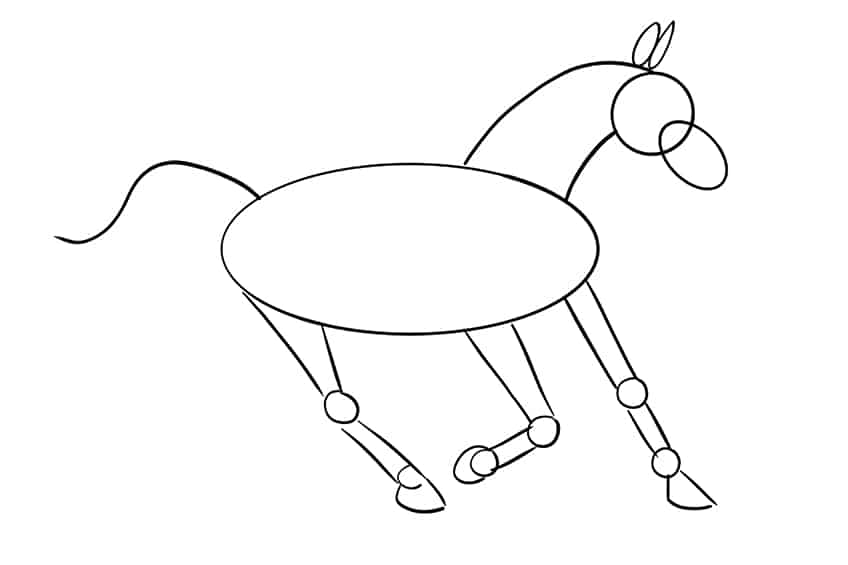
Step 10: Constructing the Horse's Final Leg
This step is the last horse leg drawing step. Begin again with your two joint circles, placing these higher than the others. Then, draw the lines that will be visible from our perspective, joining them behind the back leg you just drew. Finish this leg with the curved triangle for the final hoof.
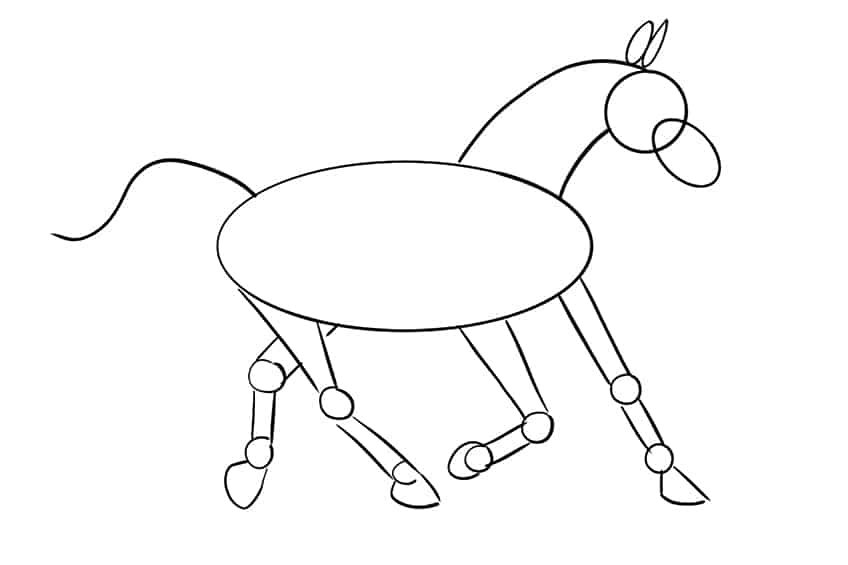
Step 11: Fine Lining the Horse's Outline
At this stage of our easy horse drawing tutorial, you have done most of the heavy lifting work. Now, it is time to use a single fine-line outline to create the final shape of your horse. Using all the construction lines you have drawn so far, you are going to use a darker pencil to outline your horse. You can begin at any point, and gently add a few curves to your outline so that you are not following the construction lines too closely.
When it comes to outlining the legs that are closest to us, you need to take the line up into the belly of the horse to add some shape and perspective.
Around the joints in the legs, add a small bump in your outline. You can also add some additional streaks along the horse's lower chest and neck to make it look a little more muscular. On the head, follow the construction lines fairly closely, but do not follow the dip between the circle and the muzzle oval. At the bottom of the nose, add the little curves that you can see in our example, and add a nostril and eye to the face. Outline the ears and add a few little curves inside them to add some depth and detail.

Step 12: Drawing the Tail and Main Blowing in the Wind
Now that we have the general outline of your horse, it is time to draw the mane and tail. The way that we are going to draw these hair features will help give the impression of movement. Using a pen, or sharp pencil, draw many curving hairlines that flow towards the back of the horse. For the mane, begin around the ears, and start to draw a few small wavy lines in the right direction. Continue to move down the back of the horse's neck, making the hairs longer as you go further back.
For the tail, use the construction line as the guideline, and draw many flowing and overlapping hairs until you are happy with the fullness.
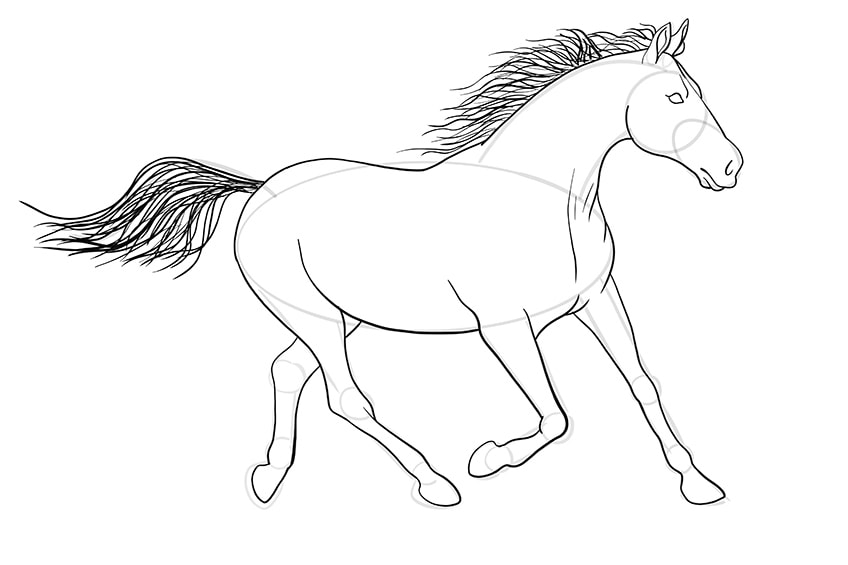
Step 13: Adding Details to the Horse's Legs
In this step, you are simply going to add details to the legs of your horse. Using the construction lines, add some curves around the joint circles, and add a few little lines in the areas of the legs that would be in shadow. You can also add small little strokes all along the legs to give the impression of hair in some places. Draw a line on the bottom of each foot to separate the hoof from the leg, and add some small lines on the hooves to give the impression of a slight shine.
When you have completed this step, you can erase all the remaining construction lines.
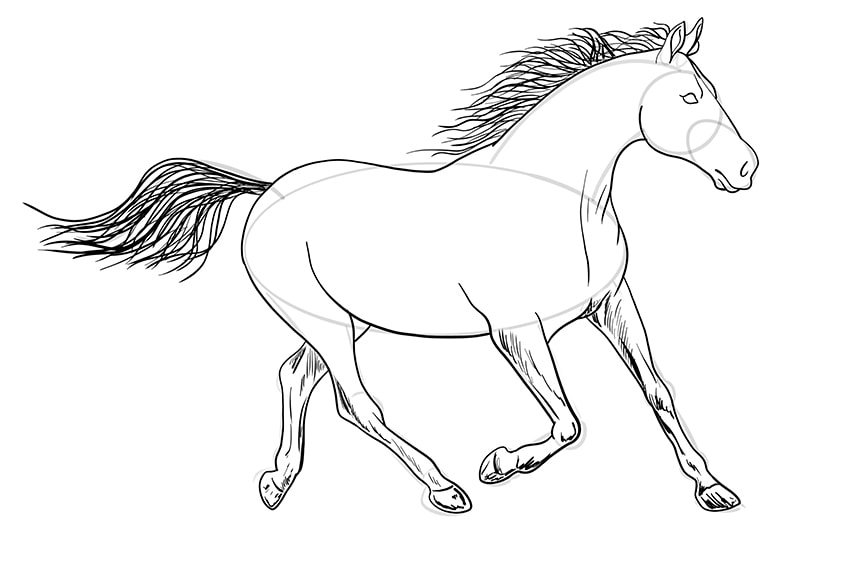
Step 13: Adding Texture and Details to Your Horse
Using the same technique as in the previous step, add cross shading lines throughout the body and head of your horse. You want to follow the general shape of the horse, and draw these textural lines in this direction. To make certain areas appear to have more muscular definition, add more cross-hatching to help them stand out. Add more textural lines in the areas that you would expect to be darker, such as around the eyes, in the ears, under the head, under the legs, and on the horse's belly.
The amount of texture you add is a personal preference. Sometimes, less is more, as too much detail can become overwhelming and detract from the realism you are trying to achieve.

Step 14: Finishing Your Easy Horse Drawing
In this final step of the drawing tutorial, you need to add some shading to add definition and make your drawing appear more realistic. Using a dark grey or black color, add some light shading around the areas where you added additional textural detail in the last step. This shading will help define the contours of the horse's body. Shade along the horse's belly, down the insides of the legs, below the head, along the nose, and down the horse's chest.

When you are happy with your level of shading, you have officially completed your horse drawing! Well done for having the patience to complete this tricky drawing tutorial. Hopefully you are feeling more confident in your drawing abilities, and we really hope that you are happy with your drawing of a horse.
Frequently Asked Questions
Does this Tutorial Make Horse Legs Drawing Simple?
Of all the different parts of a horse's anatomy, drawing the legs is one of the most tricky steps. Horses have very long legs with different joints and curves that can take some time to master. Luckily, if you are having trouble with horse legs drawing, our resident artist breaks down the process into very easy steps that help you practice and master the art of drawing a horse.
How Long Does It Take to Create a Drawing of a Horse?
Horses can be tricky animals to draw, and it may take you some time to practice and master the different elements of the horse's body. Do not be down-heartened if it does take a while for you to complete this tutorial, the longer you take to perfect something, the better ingrained the skill will be!
Source: https://artincontext.org/how-to-draw-a-horse/
0 Response to "Horse Drawings Easy Steps Horse Head Drawings Easy Steps"
Post a Comment